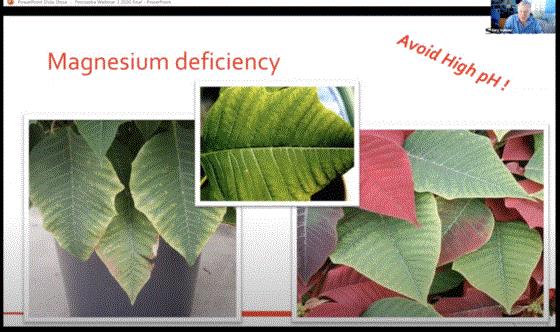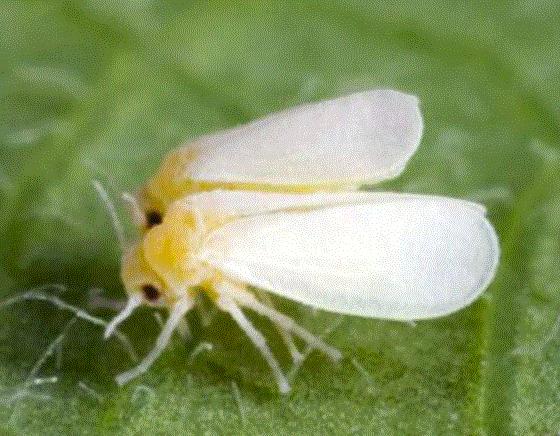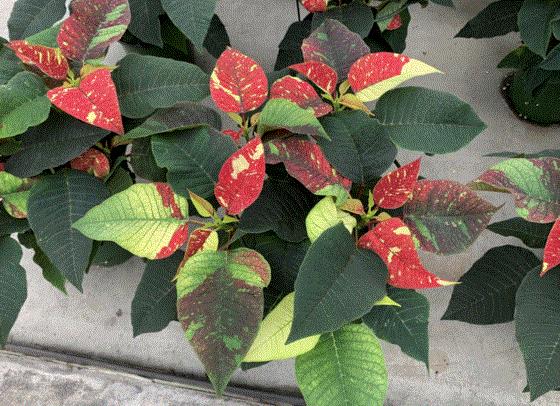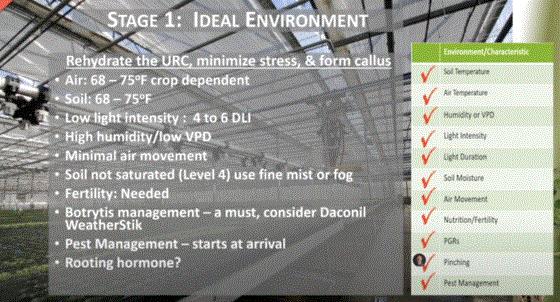Are Your Poinsettias Deficient?
As we continue the series of poinsettia production videos intended to help you and your team work through the season with timely tips and guidance, it’s time to walk the crop again and look for telltale signs of nutrient deficiencies.

In POINSETTIA VIDEO #29, our team of experts from Selecta One tackle three common deficiencies in poinsettia finished production: Magnesium, Nitrogen and Calcium. They share visual examples of what to look for and how to combat these issues. Finally, the experts spend time discussing exactly where deficiencies occur in the structure of a poinsettia plant.
It’s a short video packed with a lot of great information. This is one to share with your entire production team.
Poinsettia Videos 30 & 31: Diseases and Insects in Finished Production
We need to keep moving with the video series or your schedule will get ahead of mine, so here are two more episodes.
VIDEO #30 is all about common disease issues found in many poinsettia crops from year to year. These are the usual suspects like botrytis and pythium. As they say, “botrytis on top and pythium on the bottom.” But the presenters also discuss everything in between. The question is not “if” you will run into these diseases, but rather “when,” so be sure to watch all the way to the end of the video.

What goes with diseases? Insects, of course, so that’s where the presenters pick up in VIDEO #31.
First up are fungus gnats and shoreflies, and our experts cover ways to avoid these pests and how to attack them if they do arise. Next is whitefly, and the speakers go into detail on chemical and biological controls, including non-neonicotinoid products that have proven successful. They also spend time on effective drench and spray protocols. Stay on guard against these pests and treat them quickly when you detect them in your scouting program.
Remember, these videos, as well as plenty more, are available in a dedicated YOUTUBE PLAYLIST designed to help you and your team as you wrap up your 2021 poinsettia crop.

Nick’s Tip of the Week: Getting Caught Up On Your Poinsettias
Each week, I’ll work with my friend Nick Flax, a technical services expert at Ball, to share a concern that’s come up during one of his numerous calls with growers across North America. This week he’s going to help if you need to add some height to your poinsettia crop.
PROBLEM: Last week’s tip on managing late stretch in poinsettias apparently struck a chord with many of our Tech On Demand readers, because I’ve had growers reaching out with follow-up questions all week. As with all of my weekly tips, if you ever have questions regarding suggestions made or a more-complicated production scenario involving something I cover, please don’t hesitate to reach out. The easiest way to reach me is via EMAIL.
In several conversations with growers this week, the flipside of the question I answered last week came up: “Is there anything I can do to get my poinsettias caught up if they are a little too short?” Though poinsettias have terminal inflorescences (growth stops at the top where cyathia [flowers] form), you’re in luck because there is. If your crop still needs a little more height or your bracts are too small, here are a few things to consider:

NICK’S TIP:
Overall Plant Growth Enhancement
Make the decision to push your crop only based on graphical tracking (GT) data. GT captures how tall your crops are and their growth rate over time. Understanding the growth rate of the crop is the best predictor of whether you’ll hit your spec or the crop needs a little “encouragement” to get there.
-
Pushing growth via conventional means (increasing temperatures, feeding, heavy watering) late in the game is not a good strategy. Doing this means plants will finish soft, which means damage during sleeving and shipping is much more likely. Increasing air temperatures can also soften the plants.
-
Applying PGRs containing both gibberellic acid (GA) and benzyladenine (BA) such as Fresco and Fascination typically yields more consistent results than ones with only GA.
-
Drench applications of Fresco (note: Fascination is not labeled for drench) will enhance growth evenly across the plant, whereas sprays have a more localized effect at the spray site. Rate and number of applications needed will vary by region and cultivar, but a 2 ppm drench is a good starting point for many growers. Apply and wait a week to observe the crop’s response before reapplying (if necessary). Applying the same volume used for paclobutrazol drenches works well for many growers (1 fl. oz. per inch of container diameter + 1 fl. oz. per additional ppp).
Bract Size and Color Enhancement
-
If plant height is sufficient but bracts are smaller than you’d like, a ~3 ppm foliar application of Fascination or Fresco 7 to 14 days before anthesis (when cyathia are showing pollen) will increase bract size. Late foliar application may impact plant height. Test a few rates on different cultivars before applying to your whole crop.
-
Foliar applications of GA+BA PGRs can also deepen the color of darker-bract cultivars and brighten the bracts of white cultivars. Be aware of the risks associated with applying a foliar spray to plants with mature bracts showing color. Some growers have reported increased Botrytis pressure after applying to white cultivars, but executing proper cultural/ environmental management and a fungicide spray program should alleviate risk.

New Podcast! Structures Strategies: Build New or Refresh?
In the latest episode of my Tech On Demand podcast, brought to you by GrowerTalks, I’m joined by Paul Golden, Sales Manager for Commercial Growing at Prospiant Inc., to discuss how you should approach the decision to build new greenhouses or retrofit or repurpose your current structures to meet new crop needs or prepare for product mix shifts in the future.

Through this podcast, Paul and I touch on everything from the structural functionalities needed for your equipment to how your existing layout impacts labor and efficiency.
One key factor to consider when deciding to build new or refresh your existing facilities is the cost of maintenance, and Paul spends plenty of time on this topic. Perhaps shifting these expenses towards a new build is a better bet long-term?
The podcast concludes with a discussion geared toward the hybrid business of the grower-retailer. If you have plans to add a retail component to your business, due to increased consumer demand in the past few years, you have a whole new set of considerations, beginning with the fundamental question: Is your greenhouse structurally sound? You also need to think about the shopping environment and whether your current facility is conducive to people with a far different tolerance for the greenhouse environment than your production staff is.
Check out STRUCTURES STRATEGIES—trust me, it’s a good one!
I can’t believe we already have 30 podcasts recorded. It feels like I just started it. You can access the latest episode at the link above, but your best bet is to subscribe through your favorite podcast app. Here are direct links to the show on iTunes, Spotify, Google and Stitcher. Once subscribed, you’ll never miss an episode.

Quick Tech Tip: Phytotoxicity
Here’s something to keep in mind as you receive liners for spring 2022 production: watch for lower leaf necrosis and yellow mature leaves. When a grower sent this photo (below) to our tech team, here’s how they diagnosed the problem:

This looks similar to phytotoxicity we’ve seen on verbena from the insecticide Tristar (Acetamiprid). We’re also seeing Thiophanate Methyl causing this type of appearance, which resembles magnesium deficiency, in quite a few crops. It’s usually a bit brighter than this, though.
Success With Cuttings: New Video!
In this video, intended to help your greenhouse production team perform at its best when cuttings arrive, Dr. Todd Cavins and Dr. Nathan Jahnke move you into STAGE ONE—from when cuttings are stuck to the point when a callus forms. This stage is generally from day 3 to day 8. Your goals are simple: Keep the cuttings hydrated, maximize rooting and minimize nutrient loss. Todd and Nathan walk you through these goals and how best to achieve them.

Next, our speakers discuss the ideal greenhouse environment in Stage One, from temperature, light and humidity to fertility and pest and diseases to watch for. They end with VPD strategies that have shown success in greenhouses around the world.
Finish Line …
This week, I’m closing with a request: Please EMAIL ME some of the resources you and your production team use when you need answers to greenhouse questions. Our Tech On Demand team is working hard to build a database of trustworthy sources of information. I’d also like to share them in the newsletter. Maybe it’s a local university with a good database of research articles, or an association you support. Are there breeding company websites with easy-to-use culture and technical resources you commonly turn to with questions? Whatever you use, send it my way. Thanks!
As always, my email is bcalkins@ballhort.com if you have any comments, suggestions or challenges we can help solve.

Bill Calkins
Editor - Tech On Demand
This email was received by you and 25,349 other fine subscribers!
If you're interested in advertising in Tech On Demand, contact Kim Brown ASAP and she'll hook you up.